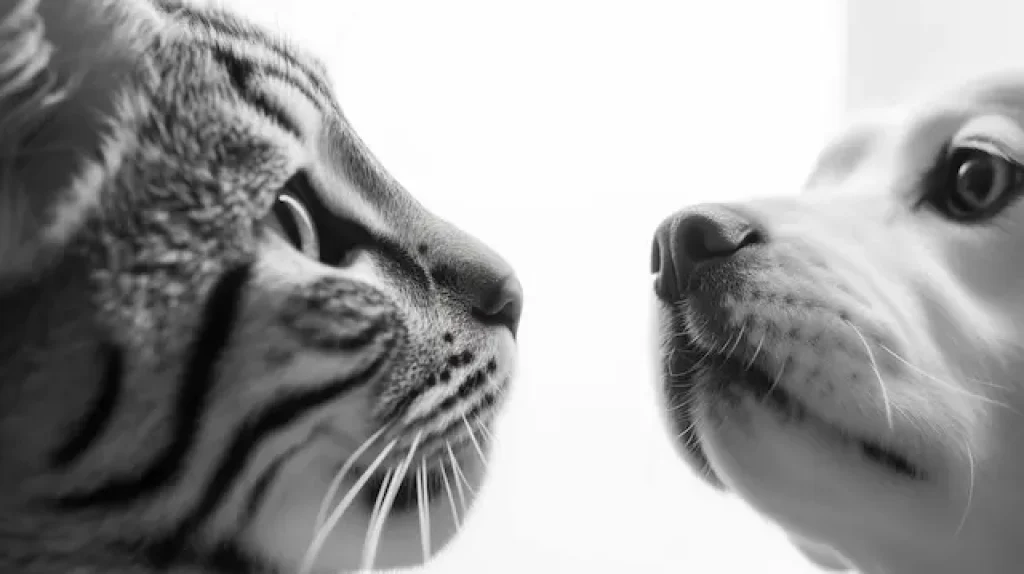When it comes to whiskers, both dogs and cats have them in abundance. These sensory hairs play a vital role in helping our furry friends navigate their surroundings, communicate with other animals, and even hunt for prey.
However, despite the similarity in name, dog whiskers and cat whiskers are not created equal. Dog whiskers are typically shorter and sturdier than those of cats.
They are located on the muzzle (around the nose), above the eyes, and under the chin. Dogs also have some longer, more flexible whiskers that protrude from their cheeks.
In contrast, cat whiskers are much longer and thinner than those of dogs. Cats have up to 24 vibrissae (whisker-like hairs) arranged in four rows on either side of their face. Additionally, they have shorter but still sensitive tactile hairs around their mouth and on their paws.
Understanding these differences between dog and cat whiskers can help us better appreciate how each species uses this unique feature to interact with its environment.
Contents
The Anatomy Of Dog Whiskers
Dog whiskers are an essential part of their sensory system, helping them navigate their surroundings. Whisker growth in dogs is influenced by genetics and age.
Generally, puppies have shorter whiskers that grow as they mature into adulthood.
To keep dog whiskers healthy, grooming techniques should be employed with care.
Brushing the fur around the whiskers can help prevent tangling or matting, which could damage the sensitive hairs. Moreover, it is important to avoid trimming or cutting dog whiskers as this can interfere with a dog’s ability to sense its environment accurately.
Understanding the anatomy of dog whiskers is crucial for pet owners who want to provide proper care for their furry companions.
Dog whiskers consist of long, thick, and deeply embedded hair follicles connected to nerve endings that detect even subtle changes in air currents, pressure, and temperature.
In contrast to cat whiskers, dog whiskers are not always visible from afar since some breeds have very short strands while others may have longer ones depending on breed characteristics.
The Anatomy Of Cat Whiskers
Like the roots of a tree, feline whiskers are deeply embedded in their skin. These long, stiff hairs protruding from their snouts are not just for show – they serve several important functions.
Whisker growth is controlled by blood vessels and nerve endings that allow cats to sense changes in their surroundings.
Unlike human hair, which grows continuously throughout our lives, cat whiskers have a lifespan of about six months before shedding naturally.
However, these shed whiskers will often be replaced with new ones within weeks.
This constant cycle of growth and shedding ensures that cats always have fully functional sensory organs on their face.
Whisker sensitivity varies across different parts of a cat’s body. Their facial whiskers are significantly longer than those found on other areas like their paws or tail.
The length difference allows them to detect even the slightest air movements that could signal nearby prey or predators. In contrast, shorter whiskers indicate lower levels of sensitivity as they don’t need to pick up as much information from the environment.
Differences In Length And Sensitivity

Whisker growth is an important aspect to consider when comparing dog whiskers and cat whiskers. While both animals have similar types of follicles that grow their whiskers, the length they can reach differs significantly.
Cats tend to have longer whiskers than dogs, with some reaching up to 3-4 inches in length. In contrast, dog whiskers typically only grow up to about 1-2 inches long.
Another key difference between dog and cat whiskers is their sensitivity levels. Whiskers are highly specialized hairs that provide sensory information to animals as they move through their environment.
Cat whiskers are more sensitive than those of dogs because they contain a much larger number of nerve endings. This allows cats to be incredibly precise in their movements and navigate even in complete darkness.
Despite the differences in length and sensitivity, both dogs and cats use their whiskers for many of the same purposes.
They rely on them heavily for spatial awareness and navigation, using subtle changes in air current or pressure against their facial fur to detect obstacles or prey nearby.
However, there are also unique ways that dogs employ their whiskers which set them apart from their feline counterparts.
How Dogs Use Their Whiskers
To put it delicately, dogs rely heavily on their whiskers to navigate the world around them.
These delicate sensory organs serve as a crucial tool for canine communication, allowing pups to understand and interpret changes in their environment.
The importance of dog whiskers cannot be overstated. Not only do they assist with balance and spatial awareness, but they also help your furry friend detect potential dangers, such as nearby predators or obstacles in their path.
In fact, some breeds even use their whiskers to locate prey while hunting!
To keep your pup’s whiskers in tip-top shape, regular grooming is key. Avoid trimming these sensitive structures and instead opt for gentle brushing when necessary. With proper care, your furry friend will continue to benefit from the invaluable assistance of their trusty whiskers for years to come.
As important as dog whiskers are, cats have quite an impressive set themselves!
Let’s explore how our feline friends utilize these unique features to navigate their surroundings.
How Cats Use Their Whiskers
As we learned in the previous section, dogs use their whiskers primarily for sensory purposes, detecting objects and changes in their environment.
However, cats have an additional layer of functionality when it comes to their whiskers, making them even more remarkable.
Cats heavily rely on their whiskers to navigate their surroundings with precision. Their whiskers, are highly sensitive and serve as an essential tool for feline spatial awareness and balance.
One of the remarkable features of cat whiskers is their ability to detect even the slightest change in air currents.
This sensitivity allows cats to gauge the size and distance of objects around them, which aids in their remarkable jumping and pouncing abilities.
When a cat jumps, its whiskers move forward and outward, providing crucial information about the environment and helping the cat land accurately.
The whiskers also play a vital role in hunting. They act as a detection system, helping cats locate prey in low-light conditions or complete darkness.
By detecting the minute changes in air currents caused by the movement of potential prey, cats can pinpoint their target with remarkable precision.
Beyond sensory functions, cat whiskers also serve as a means of communication. The position and movement of a cat’s whiskers can convey valuable information about its mood and intentions.
When a cat is relaxed or content, its whiskers are typically positioned forward. However, when a cat feels threatened or agitated, the whiskers may be pulled back against its face, signaling a defensive posture.
In addition to their facial whiskers, cats also have shorter tactile hairs on their paws. These whiskers, known as carpal whiskers, assist cats in judging the narrow spaces they can navigate and provide sensory information during activities like climbing and hunting small prey.
Frequently Asked Questions

How Do Cats And Dogs Use Their Whiskers To Communicate With Each Other?
Whisker shedding, whisker length, and growth differences are key factors in how cats and dogs use their whiskers to communicate with each other.
Whiskers function as sensory organs that help animals detect changes in their surroundings, including movement, temperature, and air currents.
Cats have longer and more sensitive whiskers than dogs, which allows them to navigate through small spaces and hunt prey more effectively.
Dogs, on the other hand, shed their whiskers regularly and rely more heavily on other senses like smell to communicate with their environment.
Despite these differences between cat and dog whiskers, both species can use them to pick up subtle cues about their surroundings and interact with each other in unique ways.
How Do Whiskers Differ In Texture And Appearance Between Cats And Dogs?
Whiskers are an important sensory tool for both cats and dogs, allowing them to navigate their environment with ease.
When comparing the texture of whiskers between the two animals, there are noticeable differences in growth patterns.
Cat whiskers tend to be longer and more flexible than dog whiskers, which are often stiffer and shorter.
Additionally, cat whiskers grow from a variety of locations on the face, while dog whiskers usually only grow from specific areas such as above the eyes or below the jaw.
Overall, although both species rely heavily on their whiskers for survival, there are distinct differences in how they use this unique feature.
Can Dogs And Cats Feel Pain If Their Whiskers Are Trimmed Or Cut?
cutting or trimming a cat or dog’s whiskers may not hurt them directly, but it can affect their ability to sense their environment and cause discomfort or pain during the grooming process.
Do Certain Breeds Of Dogs Or Cats Have Longer Or More Sensitive Whiskers Than Others?
There are certain breeds of dogs and cats that have longer or more sensitive ones than others. Breed comparison plays a role in the length and thickness of these sensory functions.
For example, some dog breeds like the Schnauzer have long, thick whiskers that aid in their sense of smell while hunting. On the other hand, certain cat breeds such as the Siamese have highly sensitive whiskers that help them navigate through dark environments with ease.
While both dogs and cats rely on their whiskers for various reasons, breed genetics play a significant role in determining their effectiveness.
Can Whiskers Help Dogs And Cats Navigate In The Dark?
Yes, whiskers can help dogs and cats navigate in the dark. Whiskers are equipped with sensory organs called proprioceptors that aid in spatial awareness and object detection.
These sensitive whiskers help dogs and cats navigate their surroundings, including dark environments, by detecting changes in air currents and providing information about objects’ proximity and texture.
They serve as an additional sensory tool that helps them navigate and avoid obstacles, making whiskers important for their nocturnal activities and overall spatial awareness.
To Culminate..

Dog whiskers and cat whiskers are fascinating and essential sensory organs for our furry friends.
While dog whiskers are shorter and sturdier, serving primarily for sensory perception, cat whiskers are longer, highly sensitive, and play a multifunctional role in navigation, balance, hunting, and communication.
Each species has evolved with whiskers uniquely suited to their specific needs and behaviors.
So, whether you appreciate the wiry dog whiskers or the delicate cat whiskers, both contribute to the remarkable abilities of our pets and deserve admiration.


